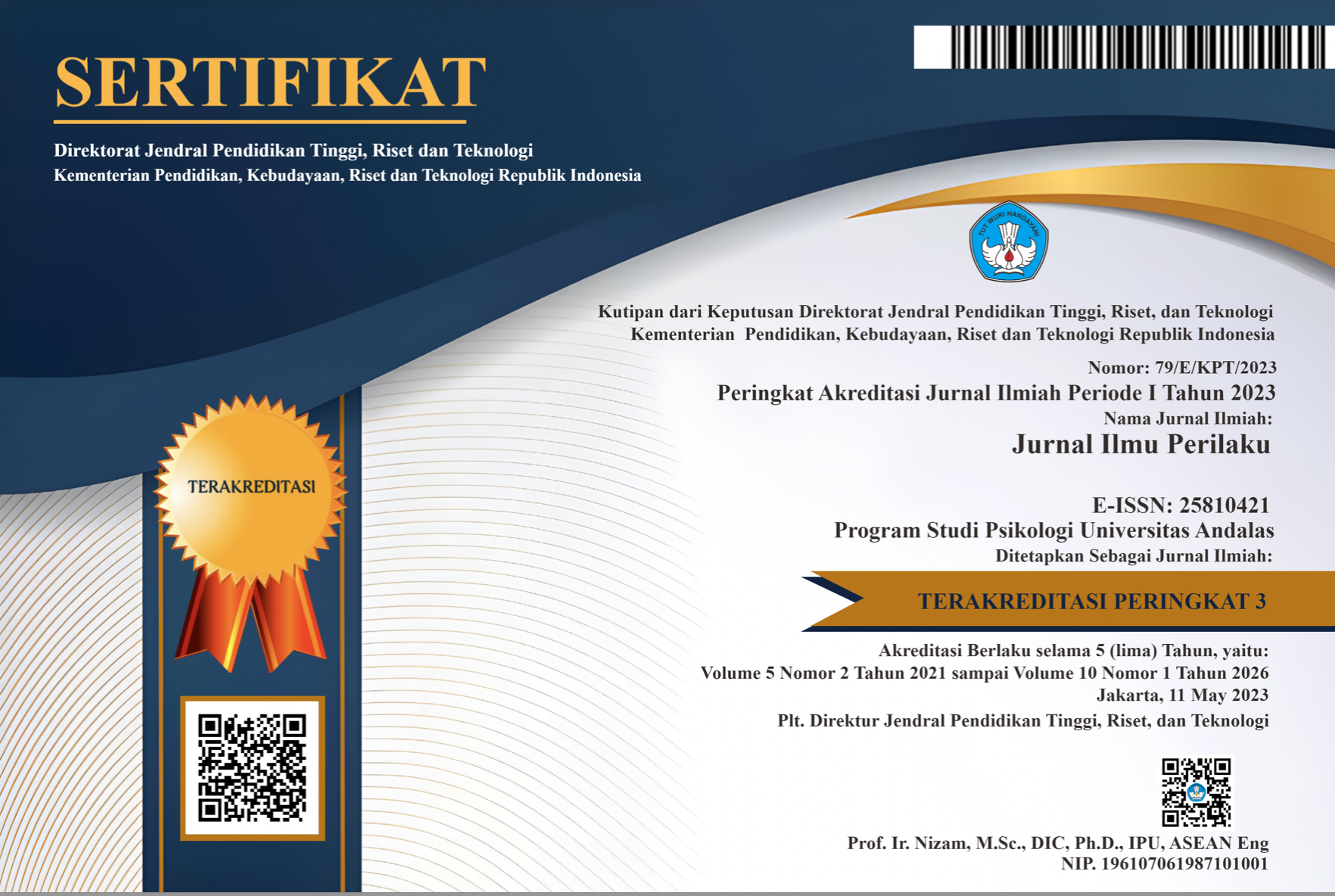Resilience, Post-Traumatic Growth, and Psychological Well-Being Among Adolescents Experiencing Parents’ Marital Dissolution
Abstract
The marital dissolution as a traumatic event for children and adolescents might yield different outcomes for each adolescent. Previous studies suggested that adolescents who have high resilience tend to experience positive changes / post- traumatic growth following traumatic events, which results in higher well-being. Hence, it is necessary to conduct research about resilience and post-traumatic growth as predictors of psychological well-being among adolescents who have been through their parents’ marital dissolution. The recent study aims to investigate the relations among those variables. A total of 56 participants (mean age: 15.27; 66.1% female) who lived in Semarang completed three measurements. Correlational, t-test, and path analysis were applied. The result suggests that both resilience and post-traumatic growth significantly and positively correlated toward psychological well-being. Furthermore, post-traumatic growth was found to have a significant partial mediating effect on the relationship between resilience and psychological well-being. These findings suggest that though promoting resilience could improve the psychological well-being of adolescents who have been through their parents’ marital dissolution, clinicians need to ensure that adolescents experience post-traumatic growth through cognitive therapy or counseling sessions to achieve better psychological well-being.
Downloads
References
Andini, A. (2019). Pertengkaran dan masalah ekonomi: penyebab utama perceraian. Lokadata. https://lokadata.id/artikel/tingkat-perceraian-lebih-tinggi-dari-perkawinan
Andrykowski, M. A., Steffens, R. F., Bush, H. M., & Tucker, T. C. (2015). Lung Cancer Diagnosis and Treatment as a Traumatic Stressor in DSM-IV and DSM-5 : Prevalence and Relationship to Mental Health Outcomes. Journal of Traumatic Stress, 28(3), 206–213. https://doi.org/10.1002/jts.22005
Boerner, M., Joseph, S., & Murphy, D. (2017). Reports of Post-Traumatic Growth and Well-Being: Moderating Effect of Defense Style. Journal of Social and Clinical Psychology, 36(9), 723–737. https://doi.org/10.1521/jscp.2017.36.9.723
Braver, S. L., & Lamb, M. E. (2013). Marital Dissolution. In Handbook of Marriage and the Family (pp. 487–516). Springer US. https://doi.org/10.1007/978-1-4614-3987-5_21
Calhoun, L. G., Cann, A., & Tedeschi, R. G. (2012). The Posttraumatic Growth Model: Sociocultural Considerations. In Posttraumatic Growth and Culturally Competent Practice (pp. 1–14). John Wiley & Sons, Inc. https://doi.org/10.1002/9781118270028.ch1
Calhoun, L. G., & Tedeschi, R. G. (2006). The Foundations of Posttraumatic Growth: An Expanded Framework. In L. G. Calhoun & R. G. Tedeschi (Eds.), Handbook of Posttraumatic Growth: Research and Practice (pp. 3–23). Lawrence Erlbaum Associates Publishers.
Connor, K. M., & Davidson, J. R. T. (2003). Development of a new resilience scale: The Connor-Davidson Resilience Scale (CD-RISC). Depression and Anxiety, 18(2), 76–82. https://doi.org/10.1002/da.10113
Greup, S. R., Kaal, S. E. J., Jansen, R., Manten-Horst, E., Thong, M. S. Y., van der Graaf, W. T. A., Prins, J. B., & Husson, O. (2018). Post-Traumatic Growth and Resilience in Adolescent and Young Adult Cancer Patients: An Overview. Journal of Adolescent and Young Adult Oncology, 7(1), 1–14. https://doi.org/10.1089/jayao.2017.0040
Harding, T., Lopez, V., & Klainin-Yobas, P. (2019). Predictors of Psychological Well-Being among Higher Education Students. Psychology, 10(04), 578–594. https://doi.org/10.4236/psych.2019.104037
Harrington, R., & Loffredo, D. A. (2010). Insight, Rumination, and Self-Reflection as Predictors of Well-Being. The Journal of Psychology, 145(1), 39–57. https://doi.org/10.1080/00223980.2010.528072
Hayes, A. F., & Rockwood, N. J. (2017). Regression-based statistical mediation and moderation analysis in clinical research: Observations, recommendations, and implementation. Behaviour Research and Therapy, 98, 39–57. https://doi.org/10.1016/j.brat.2016.11.001
Hefferon, K., & Boniwell, I. (2011). Positive Psyhology (1st ed.). McGraw Hill.
Hornor, G. (2015). Childhood Trauma Exposure and Toxic Stress: What the PNP Needs to Know. Journal of Pediatric Health Care, 29(2), 191–198. https://doi.org/10.1016/j.pedhc.2014.09.006
Hu, J., Feng, B., Zhu, Y., Wang, W., Xie, J., & Zheng, X. (2017). Gender Differences in PTSD: Susceptibility and Resilience. In Gender Differences in Different Contexts. InTech. https://doi.org/10.5772/65287
Kira, I., Lewandowski, L., Somers, C. L., Yoon, J. S., & Chiodo, L. (2012). The effects of trauma types, cumulative trauma, and PTSD on IQ in two highly traumatized adolescent groups. Psychological Trauma: Theory, Research, Practice, and Policy, 4(1), 128–139. https://doi.org/10.1037/a0022121
Leme, V. B. R., Del Prette, Z. A. P., & Coimbra, S. (2015). Social Skills, Social Support and Well-Being in Adolescents of Different Family Configurations. Paidéia (Ribeirão Preto), 25(60), 9–17. https://doi.org/10.1590/1982-43272560201503
Mahdi, H. K., Prihadi, K., & Hashim, S. (2014). Posttraumatic Growth and Resilience after A Prolonged War: A Study in Baghdad, Iraq. International Journal of Evaluation and Research in Education (IJERE), 3(3). https://doi.org/10.11591/ijere.v3i3.6316
Meyerson, D. A., Grant, K. E., Carter, J. S., & Kilmer, R. P. (2011). Posttraumatic growth among children and adolescents: A systematic review. Clinical Psychology Review, 31(6), 949–964. https://doi.org/10.1016/j.cpr.2011.06.003
Monks, F. J., Knoers, A. M. P., & Hadinoto, S. rahayu. (2014). Psikologi Perkembangan: Pengantar dalam Berbagai Bagiannya (3rd ed.). Gadjah Mada University Press.
O’Rourke, J. J. F., Tallman, B. A., & Altmaier, E. M. (2008). Measuring post-traumatic changes in spirituality/religiosity. Mental Health, Religion & Culture, 11(7), 719–728. https://doi.org/10.1080/13674670801993336
Park, C. L., Chmielewski, J., & Blank, T. O. (2010). Post-traumatic growth: finding positive meaning in cancer survivorship moderates the impact of intrusive thoughts on adjustment in younger adults. Psycho-Oncology, 19(11), 1139–1147. https://doi.org/10.1002/pon.1680
Pedoman Umum Perlindungan Anak Penanganan COVID-19. (2020). https://www.kemenpppa.go.id/lib/uploads/slider/62d2e-pedoman-umum-perlindungan-anak-penanganan-covid-19.pdf
Perceraian di Semarang Naik 3 Kali Lipat Selama Wabah Corona. (2020, June 24). CNN Indonesia. https://www.cnnindonesia.com/nasional/20200624103600-20-516800/perceraian-di-semarang-naik-3-kali-lipat-selama-wabah-corona
Potter, D. (2010). Psychosocial Well-Being and the Relationship Between Divorce and Children’s Academic Achievement. Journal of Marriage and Family, 72(4), 933–946. https://doi.org/10.1111/j.1741-3737.2010.00740.x
Ramadhani, T., Djuanedi, & Sismiati, A. (2016). Kesejahteraan Psikologis (Psychological Well-Being) Siswa yang Orangtuanya Bercerai. Jurnal Bimbingan Konseling, 5(1), 108–115.
Richardson, G. E. (2002). The metatheory of resilience and resiliency. Journal of Clinical Psychology, 58(3), 307–321. https://doi.org/10.1002/jclp.10020
Ruini, C., Vescovelli, F., & Albieri, E. (2013). Post-traumatic Growth in Breast Cancer Survivors: New Insights into its Relationships with Well-Being and Distress. Journal of Clinical Psychology in Medical Settings, 20(3), 383–391. https://doi.org/10.1007/s10880-012-9340-1
Ryff, C. D. (1989). Happiness is everything, or is it? Explorations on the meaning of psychological well-being. Journal of Personality and Social Psychology, 57(6), 1069–1081. https://doi.org/10.1037/0022-3514.57.6.1069
Ryff, C. D. (2014). Psychological Well-Being Revisited: Advances in the Science and Practice of Eudaimonia. Psychotherapy and Psychosomatics, 83(1), 10–28. https://doi.org/10.1159/000353263
Ryff, C. D. (2017). Eudaimonic well-being, inequality, and health: Recent findings and future directions. International Review of Economics, 64(2), 159–178. https://doi.org/10.1007/s12232-017-0277-4
S Pappa, V. (2013). Relationships between Parents’ Marital Status and the Psychological Wellbeing of Adolescents in Greece. Journal of Psychology & Psychotherapy, 03(02). https://doi.org/10.4172/2161-0487.1000110
Santrock, J. W. (2011). Remaja (11th ed.). Erlangga.
Savitri, W. C., & Listiyandini, R. A. (2017). Mindfulness dan Kesejahteraan Psikologis pada Remaja. Psikohumaniora: Jurnal Penelitian Psikologi, 2(1), 43. https://doi.org/10.21580/pjpp.v2i1.1323
Sun, J., & Stewart, D. (2007). Age and Gender Effects on Resilience in Children and Adolescents. International Journal of Mental Health Promotion, 9(4), 16–25. https://doi.org/10.1080/14623730.2007.9721845
Tavernier, R., & Willoughby, T. (2012). Adolescent turning points: The association between meaning-making and psychological well-being. Developmental Psychology, 48(4), 1058–1068. https://doi.org/10.1037/a0026326
Tedeschi, R. G., & Calhoun, L. G. (1996). The posttraumatic growth inventory: Measuring the positive legacy of trauma. Journal of Traumatic Stress, 9(3), 455–471. https://doi.org/10.1002/jts.2490090305
Tedeschi, R. G., & Calhoun, L. G. (2004). TARGET ARTICLE: “Posttraumatic Growth: Conceptual Foundations and Empirical Evidence.” Psychological Inquiry, 15(1), 1–18. https://doi.org/10.1207/s15327965pli1501_01
Visani, D., Albieri, E., Offidani, E., Ottolini, F., Tomba, E., & Ruini, C. (2011). Gender Differences in Psychological Well-Being and Distress During Adolescence. In The Human Pursuit of Well-Being (pp. 65–70). Springer Netherlands. https://doi.org/10.1007/978-94-007-1375-8_6
Vishnevsky, T., Cann, A., Calhoun, L. G., Tedeschi, R. G., & Demakis, G. J. (2010). Gender Differences in Self-Reported Posttraumatic Growth: A Meta-Analysis. Psychology of Women Quarterly, 34(1), 110–120. https://doi.org/10.1111/j.1471-6402.2009.01546.x
Waterman, A. S., Schwartz, S. J., Zamboanga, B. L., Ravert, R. D., Williams, M. K., Bede Agocha, V., Yeong Kim, S., & Brent Donnellan, M. (2010). The Questionnaire for Eudaimonic Well-Being: Psychometric properties, demographic comparisons, and evidence of validity. The Journal of Positive Psychology, 5(1), 41–61. https://doi.org/10.1080/17439760903435208
Yusuf, Y. (2020, September 15). Perceraian menumpuk Selama Covid-19, Terbanyak di Jawa Barat, Surabaya, dan Semarang. INews. https://www.inews.id/news/nasional/perceraian-menumpuk-selama-covid-19-terbanyak-di-jawa-barat-subaya-dan-semarang

This work is licensed under a Creative Commons Attribution-NonCommercial-ShareAlike 4.0 International License.
The non-commercial use of the article is governed by the Creative Commons Attribution license as currently displayed on Creative Commons Attribution-NonCommercial-ShareAlike 4.0 International License.
JIP's spirit is to disseminate articles published are as free as possible. Under the Creative Commons license, JIP permits users to copy, distribute, display, and perform the work for non-commercial purposes only. Users will also need to attribute authors and JIP on distributing works in the journal.
Please find the rights and licenses in Jurnal Ilmu Perilaku (JIP).
- License
The non-commercial use of the article will be governed by the Creative Commons Attribution license as currently displayed on Creative Commons Attribution-NonCommercial-ShareAlike 4.0 International License.
- Author’s Warranties
The author warrants that the article is original, written by stated author(s), has not been published before, contains no unlawful statements, does not infringe the rights of others, is subject to copyright that is vested exclusively in the author and free of any third party rights, and that any necessary written permissions to quote from other sources have been obtained by the author(s).
- User Rights
JIP's spirit is to disseminate articles published are as free as possible. Under the Creative Commons license, JIP permits users to copy, distribute, display, and perform the work for non-commercial purposes only. Users will also need to attribute authors and JIP on distributing works in the journal.
- Rights of Authors
Authors retain the following rights:
- Copyright, and other proprietary rights relating to the article, such as patent rights,
- The right to use the substance of the article in future own works, including lectures and books,
- The right to reproduce the article for own purposes, provided the copies are not offered for sale,
- The right to self-archive the article.
- Co-Authorship
If the article was jointly prepared by other authors, the signatory of this form warrants that he/she has been authorized by all co-authors to sign this agreement on their behalf, and agrees to inform his/her co-authors of the terms of this agreement.
- Termination
This agreement can be terminated by the author or JIP upon two months’ notice where the other party has materially breached this agreement and failed to remedy such breach within a month of being given the terminating party’s notice requesting such breach to be remedied. No breach or violation of this agreement will cause this agreement or any license granted in it to terminate automatically or affect the definition of JIP.
- Royalties
This agreement entitles the author to no royalties or other fees. To such extent as legally permissible, the author waives his or her right to collect royalties relative to the article in respect of any use of the article by JIP or its sublicensee.
- Miscellaneous
JIP will publish the article (or have it published) in the journal if the article’s editorial process is successfully completed and JIP or its sublicensee has become obligated to have the article published. JIP may conform the article to a style of punctuation, spelling, capitalization, referencing and usage that it deems appropriate. The author acknowledges that the article may be published so that it will be publicly accessible and such access will be free of charge for the readers.










